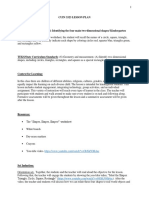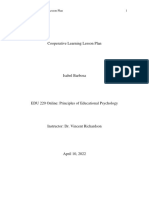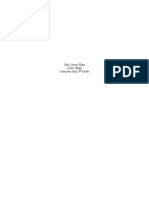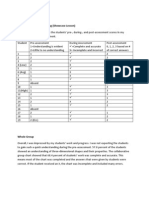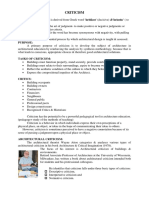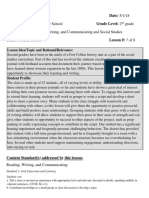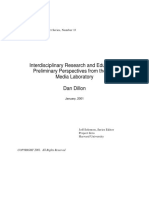Instructional Design
Uploaded by
api-176741846Instructional Design
Uploaded by
api-176741846#4 Instructional Design Lesson Plans: I planned, prepared and taught five lessons.
My lessons consisted of two science lessons, two math lessons and one read-aloud lesson. The two science lessons both focused on sorting solids based on their properties. The first had them sort them based on their observations and the second lesson had them sort the solids into either roll or stack categories. Both of these lessons utilized collaborative small group work and manipulatives. My math lesson plans were both based on geometric shapes. The first math lesson focused on having students to use spatial reasoning to visualize what shape might result by combining or subdividing. This required students to work collaboratively to investigate different plane shapes and their distinct properties. The read-aloud lesson focused on authors craft in the context of Pecos Bill by Steven Kellogg. This lesson required students to analyze the use of exaggeration in the story and why the author chose to write it this way. The final math lesson focused on threedimensional shapes and their characteristics, such as faces, edges, vertices, and shapes of faces. This lesson required the students to work collaboratively to find the different characteristics. This was my showcase lesson and an observation was completed by Dr. Horton. Both of my math lesson plans incorporate EEDA Standard 4 which is: Students will demonstrate a positive attitude toward work and the ability to work together. Technology: Technology was only utilized during my math lessons. During these lessons the Smart Board was used to display the charts they were working on in their small groups. Also, during my showcase lesson a PowerPoint game was used as a post-assessment. This PowerPoint required students to deduce the mystery shape based on their characteri stics given in the clues. My science lesson plans included uses of technology but the week that I had planned to teach them, the projector was not working. I modified my instruction to use the white board instead. Activity Analysis: Properties of Solids (Lesson One): The objective for this lesson is the students will be able to demonstrate an understanding that every solid has more than one property and practice their scientific reasoning skills during their investigations. During this science lesson, the students had to work collaboratively to separate different solids based on their characteristics. Each group of students was given a blank, large sheet of white paper and they had to group the solids based on the properties they chose. For instance, some students grouped the solids by color, shape or another property. They were to draw a circle around the group on the paper and label the groups. This instructional strategy was very beneficial to the students because
they were given the opportunity to be more creative and inventive with their groupings as long they could explain their reasoning. Properties of Solids (Lesson Two): The objective for this lesson is students will demonstrate a practical application of the shape of solids specifically that some solids rolls and others stack and students will practice their scientific reasoning skills during their investigations. During this lesson, students are given the opportunity to test each solid and can therefore apply their own results when sorting the solids. This lesson is different from the last lesson because the students are testing for specific properties rather than just their own observable properties. This lesson helps foster the idea of the scientific method during their investigation. The students use the same manipulatives from the last lesson, so they are already familiar with some of their properties before they look at them again. The students in this classroom have not had a lot of practice in collaboration, so the more time they have to work together, the more their relationships and cooperation skills will benefit. Making New Shapes (Lesson Three): The objective for this lesson is that students will recognize and name trapezoids, parallelograms, and hexagons, put shapes together to make new shapes, and identify the number of sides and vertices in each shape during investigation. During this lesson, students work collaboratively with pattern block manipulatives to practice combining and subdividing shapes to create new shapes. The students get practice working with and manipulating the number of sides, vertices and the faces of the object. In one section of this lesson, the students are given an outline of a shape that they have to fit their pattern blocks into. They also gained the understanding that when working with plane shapes, the number of sides and vertices will always be the same. This lesson accommodated for the students that needed a more hands-on approach and were able to see how different shapes fit together. Authors Craft in Pecos Bill (Lesson Four): This lesson was conducted through a read-aloud of the book Pecos Bill by Steven Kellogg. The students had previously read books about John Henry and Paul Bunyan with their cooperating teacher during their unit on folk tales. During this lesson, I began by comparing attributes of the three books through the context of exaggeration. We talk about the exaggeration they see in those books and what it meant for the story. The students also had to think about how that element changed the story. During the read-aloud students were allowed to voice their thoughts and opinions to a partner on the carpet and then some students volunteered to share whole group. The students were asked to think about examples of exaggeration during the story and we were going to add them to the visual web on the white board. This addition to the lesson helped students to visualize the different examples from the story and allowed them to refer to those examples during discussion. Then the class discussed the reasons why the author added the element of exaggeration in this tall tale and how it changed our perception of Pecos Bill. As a post-
assessment the students were able to write and illustrate their own exaggeration. This addition of a creative assignment really helped some of the students to grasp the idea. Characteristics of Geometric Solids (Showcase Lesson 5): The objective for this lesson was the student will analyze the three-dimensional shapes spheres, cubes, cylinders, prisms, pyramids, and cones according to the number and shape of the faces, edges, corners, and bases of each through investigation activity. This lesson began by having the students look through their three-dimension shape manipulatives to see if they could recognize any of the shapes. They also were asked to explain why they knew it was that shape. For instance, one student was able to guess the hexagonal prism and was able to discern because the end faces were hexagons. This was to generate prior knowledge of geometric solids and connect it to plane shapes. During the investigation section of the lesson, the students were able to work collaboratively with a partner to look at each shape to find the number of faces, vertices, edges and shapes of the faces and fill in the chart with the information. This was a hands-on approach was necessary for many of the students to grasp the concept of edges and faces of shapes. The closing activity for this lesson was a PowerPoint game that gave the students clues for the mystery shape. The students were not allowed to use their charts, but were given the opportunity to use the manipulatives that they had in front of them. This gave them the chance to count again and reinforced the concept of edges, faces, and vertices. This activity was engaging for the students and was a good way to close the lesson.
You might also like
- Learning Activity Sheet 2 - Scientific AttitudesNo ratings yetLearning Activity Sheet 2 - Scientific Attitudes3 pages
- Secrets of Mind and Reality - Vibrational Matching Requires An Identity ShiftNo ratings yetSecrets of Mind and Reality - Vibrational Matching Requires An Identity Shift2 pages
- Beginning Kindergarten-Shapes-LynchjennaNo ratings yetBeginning Kindergarten-Shapes-Lynchjenna4 pages
- Dakota State University College of Education Lesson Plan FormatNo ratings yetDakota State University College of Education Lesson Plan Format5 pages
- Lesson Plan Kindergarten Geometry - Educ 202No ratings yetLesson Plan Kindergarten Geometry - Educ 2028 pages
- Lesson Plan: Outcomes From Alberta Program of Studies Learning Objectives Assessments GloNo ratings yetLesson Plan: Outcomes From Alberta Program of Studies Learning Objectives Assessments Glo3 pages
- DSS Lions Visible Thinking Window Team ProjectNo ratings yetDSS Lions Visible Thinking Window Team Project7 pages
- 3SGD4 Identify, Describe, Sort and Compare SimpleNo ratings yet3SGD4 Identify, Describe, Sort and Compare Simple4 pages
- Math Lesson Plan Template: Name: Sarah FitzgeraldNo ratings yetMath Lesson Plan Template: Name: Sarah Fitzgerald10 pages
- List All Materials Used (I.E. Websites, Apps, Pencils, Ipads, Computers, Worksheets, Diagrams, Textbooks, Etc.)No ratings yetList All Materials Used (I.E. Websites, Apps, Pencils, Ipads, Computers, Worksheets, Diagrams, Textbooks, Etc.)3 pages
- Dakota State University College of Education Lesson Plan FormatNo ratings yetDakota State University College of Education Lesson Plan Format4 pages
- Example of ASSURE Model - Understanding GeometryNo ratings yetExample of ASSURE Model - Understanding Geometry4 pages
- EDUC 2220-Educational Technology Lesson Plan Shapes and MeasurementNo ratings yetEDUC 2220-Educational Technology Lesson Plan Shapes and Measurement6 pages
- Cooperative Learning Lesson Plan Edu 220 4-10-2022No ratings yetCooperative Learning Lesson Plan Edu 220 4-10-20227 pages
- Lesson Plan Template If Used Independent of A Unit Plan of SLONo ratings yetLesson Plan Template If Used Independent of A Unit Plan of SLO8 pages
- 9196 Mccallie Day Unit 5 Mastery Mccallie 99970 594363050No ratings yet9196 Mccallie Day Unit 5 Mastery Mccallie 99970 5943630506 pages
- Unit Lesson Plans Joelle Wight Geometry Unit, 4 GradeNo ratings yetUnit Lesson Plans Joelle Wight Geometry Unit, 4 Grade32 pages
- Big Ideas for Growing Mathematicians: Exploring Elementary Math with 20 Ready-to-Go ActivitiesFrom EverandBig Ideas for Growing Mathematicians: Exploring Elementary Math with 20 Ready-to-Go Activities4.5/5 (3)
- Name: Dylan Brooks Grade Level: 2 Time (Needed For Lesson) : 30 Minutes Intended Curriculum: SC Science Academic IndicatorsNo ratings yetName: Dylan Brooks Grade Level: 2 Time (Needed For Lesson) : 30 Minutes Intended Curriculum: SC Science Academic Indicators4 pages
- Benthams Attack On Human Rights. HUGO BEDAUNo ratings yetBenthams Attack On Human Rights. HUGO BEDAU20 pages
- Theories of Truth in Contemporary PhilosophyNo ratings yetTheories of Truth in Contemporary Philosophy14 pages
- Monty Python and The Quest For The Perfect Fallacy: ExamplesNo ratings yetMonty Python and The Quest For The Perfect Fallacy: Examples9 pages
- Teacher Working Conditions That Matter - Evidence For ChangeNo ratings yetTeacher Working Conditions That Matter - Evidence For Change125 pages
- Stone (2010) - Reserach Strategies in IO Psychology PDFNo ratings yetStone (2010) - Reserach Strategies in IO Psychology PDF36 pages
- Introduction To The Philosophy of The Human Person Lesson 1No ratings yetIntroduction To The Philosophy of The Human Person Lesson 129 pages
- Rosenthal - The Place of Politics in The Philosophy of Ibn RushdNo ratings yetRosenthal - The Place of Politics in The Philosophy of Ibn Rushd34 pages
- Interdisciplinary Research and EducationNo ratings yetInterdisciplinary Research and Education51 pages










